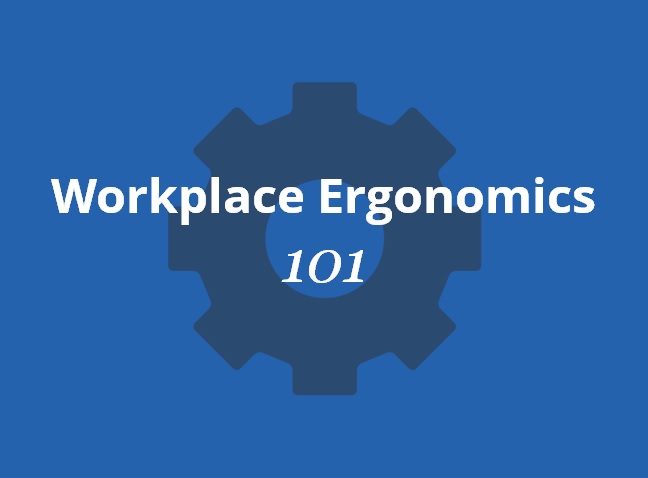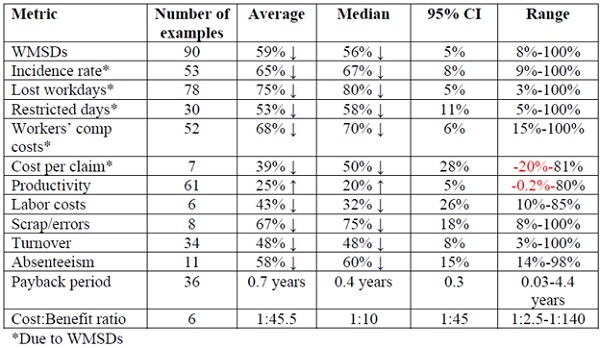This is an installment of the Workplace Ergonomics 101 series.
The first step to improving your workplace ergonomics process is to do a gap analysis.
You need to know where your process currently stands verses where you want it to be.
In other words, you need to establish what success looks like so you can set goals and make incremental progress toward those goals.
So what is possible with an effective ergonomics process?
Ergonomics Success
The Washington State Department of Labor and Industries reviewed 250 ergonomics case studies to reveal the impact of ergonomics on business goals like cost savings, productivity and product quality.
They found that an ergonomics process was able to significantly improve these metrics. The picture below is a summary of the results:
These findings clearly illustrate the benefits of a successful ergonomics process.
For more, here are a few specific ergonomics success stories:
How to get there: Ergonomics as a Process
We know from the research and success stories presented above that ergonomics can have a positive impact on the key health and safety metrics you’re measuring for your company / facility.
That is what ergonomics success will look like for you as well, but how do you get there? Where do you get started?
First, it’s important to view ergonomics as a process that is aligned with continuous improvement efforts – not just a one-time program or project.
For the ergonomics process to achieve long-term success, the process must have clear goals, be well documented and be reviewed regularly.
The Ergonomics Improvement Process
The goal of the reactive part of your ergonomics improvement process is to identify and reduce ergonomic risk factors already present in the workplace.
The Ergonomics Improvement Process:
- Develop a prioritized list of jobs for ergonomic analysis. This prioritized list should be developed by the ergonomics team based on an initial facility tour, review of MSD history and data collected by employee surveys.
- Conduct objective ergonomic analysis. This analysis will objectively measure risk for each job in the workplace and help you develop an ergonomic opportunity list.
- Develop an ergonomic opportunity list. Developing an ergonomic opportunity list allows you to prioritize company resources in order to effectively and efficiently reduce risk by putting the appropriate controls in place.
- Determine best solution with team approach. A multi-disciplinary team should be involved in determining the best controls for implementation.
- Obtain approval and implement solution. If the improvement requires a significant capital expenditure, cost-justify the solution to gain approval.
- Evaluate impact of the ergonomic improvement. Once improvements are in place, close the loop on the project by evaluating the ergonomic improvement and measuring its effectiveness.
Proactive Ergonomics:
The goal of the proactive part of the ergonomics process is to design with ergonomics in mind so that ergonomic risk factors are minimized from the start. The earlier ergonomics is considered in the planning, design and implementation of new equipment and work processes, the better.
The ergonomics improvement process will systematically reduce ergonomic risk factors. It’s important to measure both leading and lagging indicators and look for continuous improvement opportunities every step of the way.
For best results …
To achieve the best results, your ergonomics and MSD prevention process should be comprehensive and include a strong education/training program and a proactive early intervention strategy.
Education and training. Empower the people throughout your organization to be successful. It is critical that managers, supervisors, technical staff and all team members at your company have the tools and information they need to be successful. Group training plus 1-on-1 education sessions guarantee the message is getting through.
Early intervention. Prevent worker fatigue & discomfort from developing into an injury. The best MSD prevention programs use proactive early intervention consultations to seek out and resolve early warning signs of MSDs. The earlier you can find the issue, the sooner it can be resolved.
Ergonomics Plus Success Stories
This comprehensive approach to workplace ergonomics and MSD prevention is how we get results for our clients.
Here are a few case studies illustrating the impact of a comprehensive prevention process:
- Case Study: 93% decrease of OSHA Recordable injuries
- Case Study: 91% decrease of MSD-related cases
- Study: Cost reduction of Ergonomics Plus clients
Additional Ergonomics, MSD Prevention & Wellness Resources
To help you execute on an ergonomics improvement process at your facility, here are a few tools of the trade we’ve made available on our website at no charge:
- Ergonomic Improvement Process Flowchart [PDF]
- Step-by-Step Guides to our Recommended Ergonomic Assessment Tools
- Employee Ergonomics Survey
- How to Cost-Justify Ergonomic Improvements
- The Ultimate Guide to MSD Prevention
For more practical ergonomics tips and resources, sign up for the Ergonomics Plus newsletter. You’ll be the first to know when we release new ergonomics and MSD prevention resources.

